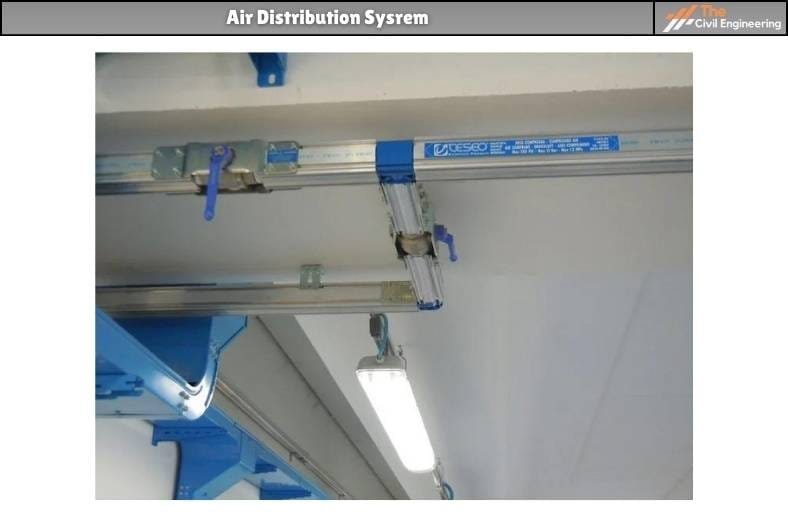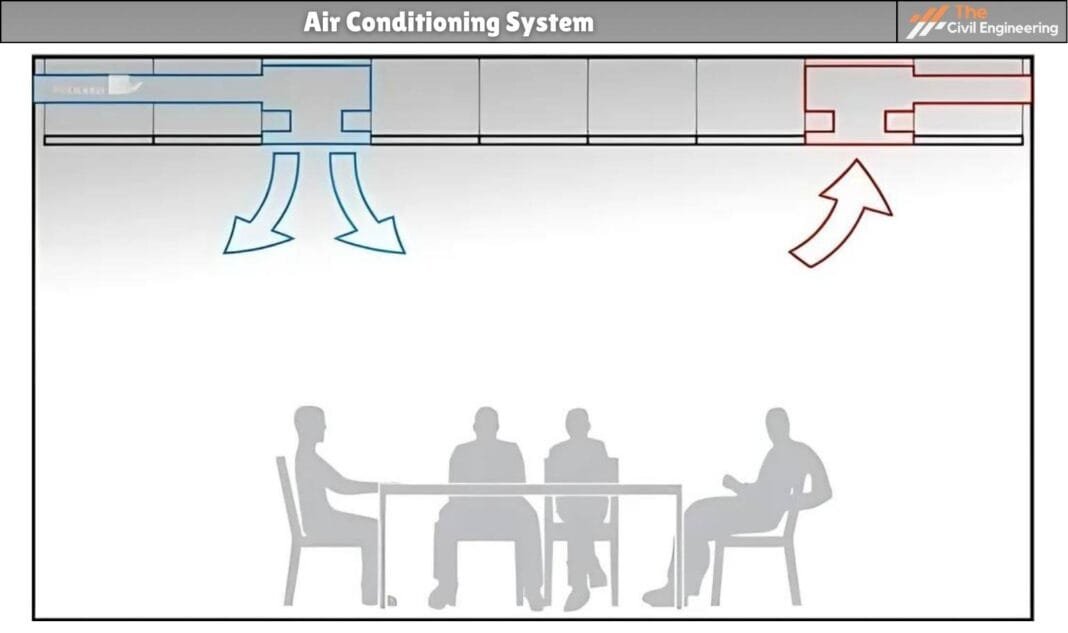In this article, we will discuss the air conditioning system
1. Introduction
Air-conditioning may be defined as the process of treating air so as simultaneously its temperature, humidity, purity, and distribution to meet the of the conditioned space.
The various requirements of a conditioned space may and the health of human beings, the needs of certain industrial processes, the efficiency of commercial premises, etc.
2. Purposes of Air Conditioning
Air-conditioning is resorted to for the following purposes:
(i) It helps in preserving or maintaining the health, comfort, and convenience of occupants of the residential buildings.
(ii) It helps in improving the quality of products in certain industrial processes such as artificial silk, cotton cloth. etc. In other cases of industries, it provides comfortable working conditions for the workers, resulting in an increase in production.
(iii) It helps in marking the commercial premises, such as shops banks, offices, restaurants, etc., more active and efficient.
(iv) It provides more comfortable entertainment in theatres etc.
(v) In the case of air-conditioned railway/roadways coaches, or air travel, the journey becomes more comfortable.

3. Essential of Air Conditioning System
The following are the essentials of an air conditioning system:
1. Filtration.
2. Heating (in winter season).
3. Cooling (in summer season).
4. Humidification.
5. Dehumidification.
6. Air circulation or distribution.
3.1. Filtration
The aim of the filters is to exclude incoming air dust particles, ash, chemical soot, bacteria, and other micro-organisms, so that clean air is obtained. The filters should possess the following qualities:
(i) They should be capable of removing dust, ash, chemical soot, bacteria, etc., from the incoming air.
(ii) They should be capable of holding a moderate amount of dust, cleaned from incoming air, on their surface without affecting their working efficiency. Filtering media should be of some fibrous material such as spun glass, steel wool, porous paper, wood fiber, etc. so that dust can adhere to it.
(iii) They should offer low frictional resistance to the flow of air.
(iv) They should be workable under a sufficient range of air velocities.
(v) They should afford easy cleaning, either manually or automatically.
Types of Filters
Filters may be of the following types
(i) Viscous type filters
These are made of mats or screens of split wire or glass wool or of similar material and coated with non-drying viscous oil so that dust in the incoming air can be caught and removed.
They may be either of unit type or automatic type. In the unit type, the mats are replaced for cleaning and In the automatic type, an endless moving chain is provided over the mat so it is mechanically rotated in a continuous cycle of air cleaning, removal of air-pollution particles, and replacement of viscous filter media.
(ii) Dry filter
They are made of cloth such as flannel, cellulose, felt, etc., which is discarded when it becomes dirty.
(iii) Spray washers
The incoming air is allowed top where dust as through water sprays, dust and fumes are removed by drops of water.
(iv) Electric precipitators
These remove the dust by ejecting it to a strong electric field and then getting it attached to the negative electrode. The particles collected on the negative electrode are removed at intervals. The initial installation cost of this is high but the operational cost is low.
3.2. Heating
The heating of air is necessary for winter, so as to compensate for the heat loss from the room. Pre-heating of incoming air may be done by passing it over warm air furnaces, or by coils around which hot water or steam is circulating.
| Read Also: Intake Structure |
3.3. Cooling
Cooling of the incoming air is necessary for summer. As stated, previously, there are two methods of cooling the air
(i) direct expansion system, and
(ii) chilled water system.
In the direct expansion (DX) system, the principle of mechanical refrigerant is used, wherein a volatile refrigerant is compressed, cooled, allowed to expand, and then it is passed through coils. These coils absorb the heat from incoming air.
In the chilled water system, a secondary medium such as water is utilized to cool the air. The incoming air is circulated around the coils containing chilled water. Thus, the refrigerant first cools the water and then the water cools the air. Chilled water is produced in the refrigeration plant housed in the main plant room.
3.4. Humidification
Humidification or addition of water to air is necessary for winter when air, because of its low temperature, has very low humidity. For ordinary conditions, humidification can be done by allowing the incoming air to pass through pans of water or wetted cloth strips.
However, when large volumes of air are handled, humidification is accomplished by spray humidifiers. In the latter case, it is essential to install eliminator plates arranged in a zig-zag manner so that fine water drops contained in humidified air are removed. Excess humidification should be avoided since it results in condensation on room surfaces.
3.5. Dehumidification
In this process, a certain required amount of water is extracted from the air. This is done in summer when the incoming air is cooled and dehumidified before the entry into the room. It’s accomplished by
(i) condensation, or by
(ii) desiccation.
In the former method, the temperature of the air is first brought down below the dew point and then condensed out the required quantity of moisture from it; the air is then reheated to the desired temperature with dry heat.
In the desiccation method, either absorbent are used or adsorbents are used. The absorbents, such as the solutions of salts of calcium or ammonia, possess the capacity to absorb excess moisture from the air.
The air is passed through the beds of small particles of these absorbents and is thus dehumidified. The adsorbents such as silica gels and activated alumina, allow moisture to stay on from their surfaces. These absorbents can be reactivated by removing the collected moisture on their surfaces by heating.
| Read Also: Impurities in Water |
3.6. Air Circulation or Distribution
This is one of the most essential requirements and the efficiency of the system depends largely on the air circulation or distribution system. The minimum fresh air requirements, as recommended by Indian Standard, are given in. Air circulation is achieved by the following:
(i) air pumps,
(ii) air delivery system consisting of supply and return ducts, and
(iii) air distribution system consisting of inlets and outlets.
Read More: Soil Erosion
Read More: 3rd Angle Projection

